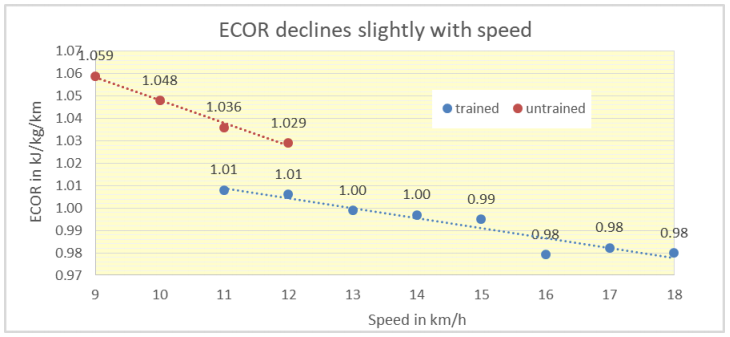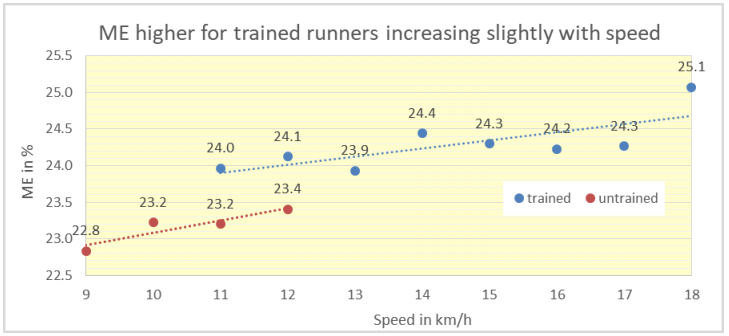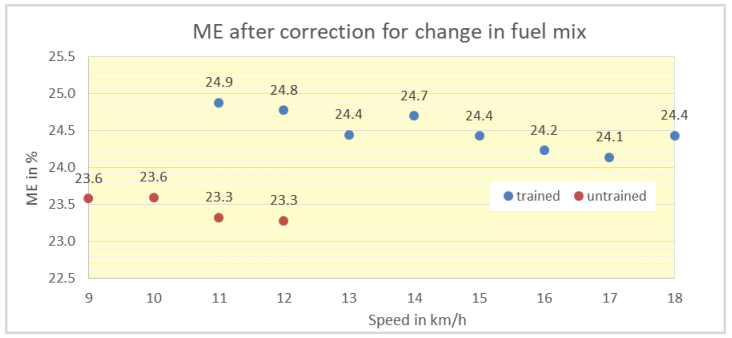The impact of speed on running economy

In our book (www.thesecretofrunning.com) we have described our initial treadmill research on 14 test runners in the physiological laboratory of the Dutch Sports Medical Center SMA Midden Nederland. We were quite impressed by the results which showed that the Stryd power data closely correlated to the VO2, which has always been considered as the gold standard in physiological research.
Recently, we have carried out a new research project in cooperation with the physiological laboratory of prof. Maria Hopman at the Radboud University of Nijmegen (RUN), the Netherlands. A full scientific paper on the project has been submitted to the Journal of Sports Sciences and Medicine. In order to share our results with the running community at large, we have written 4 short popular papers (numbered 24-27) on the main findings:
1. The (close) relationship between Stryd power and VO2
2. The impact of speed on the running economy (ECOR and RE)
3. The impact of cadence on the running economy (ECOR and RE)
4. The physiological differences between trained and untrained runners
This paper is the second of this series. The pictures below show the authors during the treadmill tests as well as some of the laboratory equipment at RUN. The left picture also shows the primary investigator, MSc-student Rick Sniekers.

Trained runners need both less power as well as less oxygen than untrained runners
The project included measuring the VO2 (in ml O2/kg/min) and Stryd power (in Watt/kg) of 21 runners (11 trained and experienced distance runners and 10 untrained students) at 5 different speeds (maintained during 3 minutes, increased in 4 steps of 1 km/h to lactate threshold). This means that we got a total of 21*5 = 105 data of VO2 and power.
From the power data, we calculated the Energy Cost of Running (ECOR) with the formula:
ECOR (kJ/kg/km) = P (Watt/kg)/v (m/s)
As an example we use a P of 3.4 Watt/kg and a speed of 12 km/h (3.33 m/s), so the ECOR is 3.5/3.33 = 1.02 kJ/kg/km.
From the VO2 data we calculated the oxygen cost of running, commonly referred to as the Running Economy (RE) with the formula:
RE (ml O2/kg/km) = 60/3.6*VO2 (ml O2/kg/min)/v (m/s)
As an example we use a VO2 of 45 and a speed of 12 km/h (3.33 m/s), so the RE is 60/3.6*45/3.3 = 225 ml O2/kg/km.
We have summarized the results for the two groups and the different speeds in the table below. One of the most striking findings is that trained runners were consistently more economical than untrained runners, both in terms of the mechanical energy that they needed for running (ECOR) as well as the amount of oxygen that they used (RE). The average RE of untrained runners was 237 ml O2/kg/km which was 10% higher than the average for trained runners (215 ml O2/kg/km). The average ECOR of untrained runners was 1.04, which was 5% higher than the average for the trained runners (0.99 kJ/kg/km). We conclude that training results in 2 important benefits:
1. The running technique improves, which leads to a 5% lower ECOR
2. The metabolic efficiency improves, which leads to an even greater reduction of the RE to 10%
In the earlier paper (#24), we already noted that the ME of our trained runners was higher than that of the untrained runners (24% vs 23% or a relative increase of 4%). This explains the discrepancy between the 10% difference in RE as compared to the 5% difference in ECOR of the two groups.

ECOR declines slightly with speed, RE declines more
We have prepared the 2 figures below to illustrate this effect. Next to the big difference between untrained and trained runners, they show the consistent impact of speed on running economy.
As speed increases, the ECOR reduces slightly in both groups by some 2-3%. The decline of RE is somewhat higher, some 5-7%. The correlation between the data is quite impressive and even more so when we realize that the data points represent a heterogeneous set of runners. This confirms our earlier findings that the daily Stryd ECOR data can be used very well to optimize training and running technique, which will improve the RE as well.


Impact of fuel mix
From a physiological point of view, we can understand the different responses of ECOR and RE with speed. As speed increases, the fuel mix in the muscles switches gradually from fatty acids to glycogen. Glycogen produces some 12% more energy per liter of O2 as compared to fatty acids (19.8 J/ml vs 17.6 J/ml) so less oxygen is required. We have prepared the two figures below to illustrate this effect. In the first figure, we have calculated the theoretical metabolic efficiency (ME) based on a constant average energy yield (EY) of oxygen of 19 J/ml. This seems to indicate that the ME increases slightly with speed. However, in the second figure we have corrected for the expected change in fuel mix, which results in the more likely result that the ME is more or less constant with speed (but differs significantly for trained and untrained runners as stated before).


Conclusions
We found a significant and consistent difference between the trained runners and the untrained runners. The results of the trained runners were superior in various aspects:
1. They needed 5% less mechanical energy (ECOR 0.99 vs 1.04 kJ/kg/km)
2. They needed 10% less oxygen (RE 215 vs 237 mlO2/kg/km)
3. Their metabolic efficiency (ME) was 4% higher (24% vs 23%)
The impact of speed on ECOR and RE was found to be as follows:
1. ECOR decreases slightly with speed (by some 3%)
2. RE decreases to a larger extent (by some 6%)
3. The difference can be explained by the change in the fuel mix (towards more glycogen at higher speed)
These results confirm our earlier findings that the Stryd power data and in particular the ECOR can be used very well to optimize training and running technique on a daily basis. Improvements in training should lead to both lower energy cost (ECOR) as well as oxygen cost (RE) of running at a certain speed.
If you would like to purchase The Secret of Running (or the German version, Das Geheimnis des Laufens), you can do so at the bottom of store.stryd.com.

